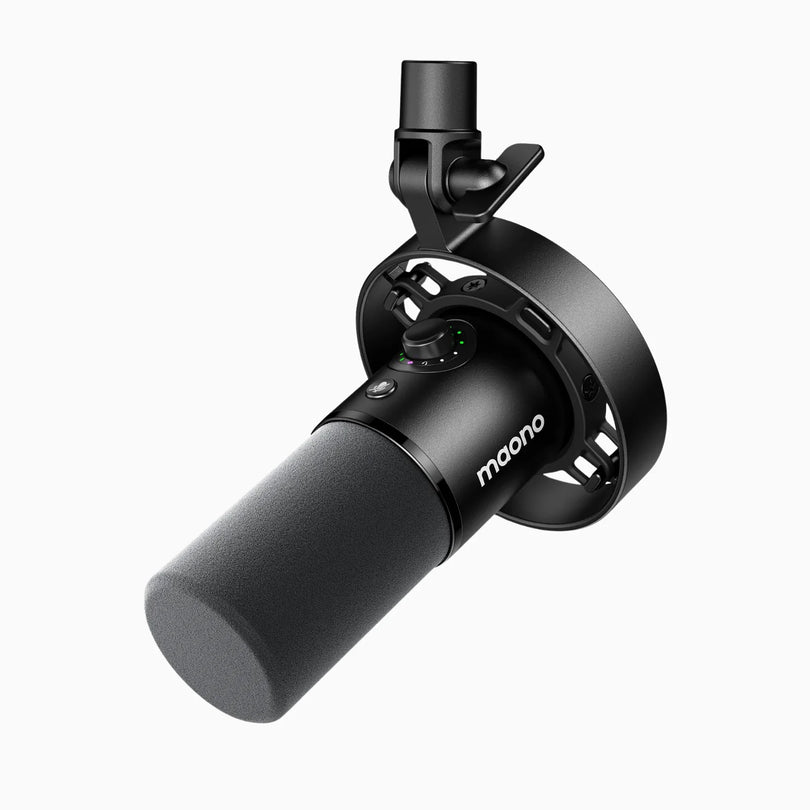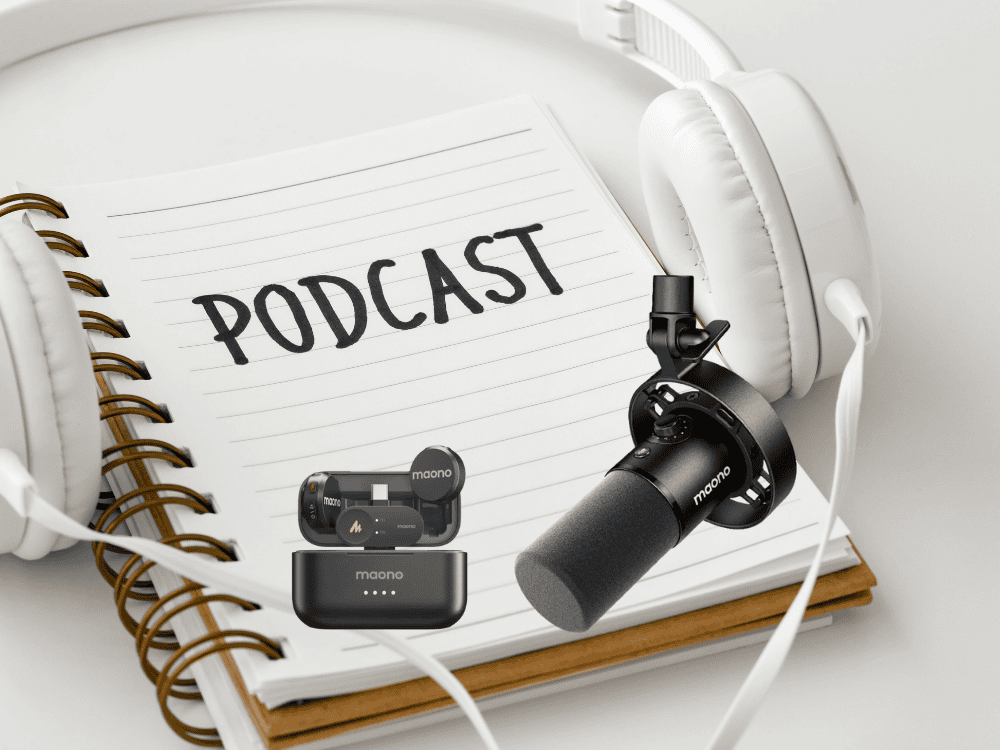A complete podcast studio equipment setup at home can be a great help to podcasters in content creation since high-quality audio is essential to your program's success. To ensure that your listeners can concentrate on your words without being distracted by background noises, you will need a decent home podcast setup. It provides you control over your surroundings and aids in obtaining the finest audio quality.
How to Setup a Podcast Studio: A Step-by-Step Guide
Here's a step by step podcast setup tutorial to create a professional podcasting studio setup on a budget:
Step 1: Choose a Suitable Space for Your Home Podcasting Studio Setup
When choosing a room for a home recording studio, it is indisputable that you should select a space with the least external noise.
- Avoid rooms near loud roads or construction sites
- Avoid large, empty spaces, especially square rooms, which can create echoes and muddy your audio
- Staying away from rooms with low ceilings is wise, too, as low ceilings reflect too many unwanted echoes, making recordings sound murky and confused
The size of your home recording studio will depend on how you intend to use it. If you are a personal podcaster, a regular spare room or bedroom will work well.
Step 2: Soundproofing and Acoustic Treatment
Proper soundproofing and acoustic treatment is necessary to reduce sound reflections and improve the quality of your recording. The most common selections are soundproofing foam boards. Attach them to hard surfaces like empty walls or the faces of cabinets will greatly absorb sound and soften your walls. To create a controlled and aesthetically pleasant environment, use bass traps or diffuser panels on the studio's ceilings and flooring to reduce undesired reverberation and manage sound reflections.
Step 3: Essential Equipment for Your Home Podcast Setup
A home studio equipped with good equipment will greatly guarantee high-quality audio recording. One of the most important parts is microphone selection, there are many types of podcasting microphones.
Two main types of microphones on the market are dynamic microphones and condenser microphones, both of which have their own characteristics. For details, please click the following article to understand the difference between the two:
What is the Main Difference Between Dynamic and Condenser Microphones?
According to the connection method, it is divided into USB microphone, XLR microphone and 3.5mm microphone. Which one is suitable for the home studio? Introducing PD200X for a podcast microphone:
Maono PD200X XLR/USB dynamic microphone
For home recording studios, it is sufficient for most of your needs.
- As a dynamic microphone, the PD200X podcasting microphone is less sensitive thus rejecting much noise in the background.
- The cardioid polar pattern makes the microphone normally records sound from the front, so it is ideally suited to picking up your voice.
- In addition to high sound quality, the PD200X podcasting microphone uses the USB/XLR dual-mode design, which offers greater compatibility with a wider range of devices.
- The microphone is equipped with Maono Link software, allowing you to adjust the EQ, tone, compressor, limiter, and other settings for optimal audio quality through an intuitive and simple interface.
By the way, consider acquiring a reliable audio interface, headphones, and microphone stand or boom arm. These essential pieces of affordable podcast studio equipment allow you to get more done with less effort.
Recommended At Home Podcasting Equipment:
1. MaonoCaster E2
The MaonoCaster E2 is an all-in-one podcast production studio with multi-channel mixing and customizable sound pads. It offers real-time voice effects like reverb and pitch control, perfect for live streams and podcasts.
Special Features:
- Dual microphone inputs with USB-C connectivity
- 6 customizable sound pads and built-in voice effects
Watch this video:
2. Maono PD400X Microphone
The Maono PD400X is a dynamic microphone with both USB and XLR connectivity, ideal for podcasting and streaming. Its cardioid pattern ensures clear, noise-free audio, with built-in gain control and real-time monitoring.
Special Features:
- USB/XLR dual output with touch-panel controls
- Integrated pop filter and 3.5mm headphone jack
3. XLR Microphone Cables
Maono’s XLR microphone cables provide professional-quality audio transmission with minimal signal loss. They feature durable connectors and shielding to prevent interference in studio or live setups.
Special Features:
- High-grade shielding for clear audio
- Sturdy, long-lasting connectors
Step 4: Proper Lighting
Lighting effects in interior decoration are not only the role of lighting. The color, brightness, and location of the lighting can be used to create a variety of different atmospheres for the recording studio. Soft, diffuse light sources are advisable to avoid shadows and to enhance visual layering. A comfortable and relaxing studio will inspire your creativity even more.
Step 5: Organization and Optimization
Keeping your home studio space organized and tidy allows you to improve your efficiency. When you purchase more and more equipment and wire, the orderly placement of them in a relatively fixed location is also very conducive to your workflow and maintenance of equipment.
Professional recording studios usually have a comprehensive cable management system, which can also be applied to our home recording studio. It helps us to establish a more professional, neat, organized, and distraction-free working environment.

By taking a suitable room for acoustic treatment and decoration, purchasing necessary equipment, and optimizing their placement, you’ll create a podcast studio that’s professional at home. If you are committed to providing great podcasts then building a home studio like this will be a great help to your career.
Certainly, the Maono PD200X podcasting microphone will also become the mainstay in your creation whether you're getting ready to start a podcast or if you're an experienced podcaster searching for higher recording quality.
On the other hand, if you plan to use a much more simple setup like a smartphone or recording your podcast, you can also read this article: Record & Launch Your Podcast Using Just Your Phone
Frequently Asked Questions:
1. What is the best home podcast setup for beginners?
The best podcast recording setup for beginners includes a dynamic microphone like the Maono PD400X, the MaonoCaster E2 or AME2 for easy mixing, headphones for monitoring, and basic acoustic treatment like foam panels.
2. How do I optimize my home podcast setup for better sound quality?
Use a high-quality microphone with a pop filter, position it properly (6-12 inches from your mouth), and minimize background noise. Enhance acoustics with foam panels or curtains, and adjust EQ and gain settings on a mixer like the MaonoCaster E2 for balanced audio.
3. How do I set up a home podcasting studio?
Choose a quiet room, invest in a quality microphone, audio interface, headphones, and a pop filter. Arrange your equipment on a sturdy desk, use recording software, and test your audio setup for optimal sound quality.
4. How can I soundproof my podcasting studio?
Use acoustic foam panels, carpets, and curtains to absorb sound. Place bass traps in corners, seal gaps around doors and windows, and position your microphone away from reflective surfaces to minimize echo.
5. How much does it cost to build an at home podcast setup?
With affordable podcast studio equipment, you can start for under $100 using a budget USB mic and free software.
6. How to set up a podcast studio on a budget?
Start with essentials: a good USB microphone, headphones, and free recording software like Audacity. Record in a quiet room and use DIY soundproofing (blankets, rugs, curtains) to cut costs.
7. What is the best room for a podcast setup?
Choose a small, quiet room with minimal echo. Carpeted floors, soft furnishings, and curtains help absorb sound, making your audio cleaner and more professional.
8. What equipment do I need to set up a podcast studio?
At minimum, you need a microphone, headphones, and recording software. For a more professional setup, add an audio interface, mic stand, pop filter, and acoustic panels.
Conclusion
Creating a professional podcast studio setup is achievable with the right equipment, proper soundproofing, and an organized setup. By investing in quality microphones, interfaces, and acoustic treatments, you can produce clear, professional audio that elevates your podcast. If you’ve ever wondered how to set up a podcast studio, the process starts with choosing the right gear and optimizing your recording space. Start building your ideal podcasting studio today and turn your creative ideas into engaging, high-quality content for your audience. Check out these professional-quality podcasting studio equipment bundles from Maono.com today!
For more on choosing the right mic, read the following articles about:
Choosing the Best Podcasting Mic For your Setup: Tips for Beginners
Essential Guide to Choosing the Right Podcast Microphone for Success
Essential Guide to Podcasting: Top Microphones & Soundproofing Tips












